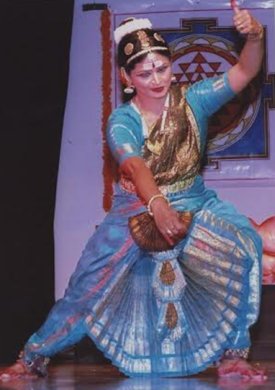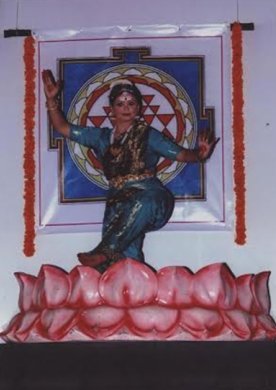
|   |

|   |
Informative lec-dem by Dr. Padmaja Suresh - Sruthi Kumar e-mail: sruthidance@gmail.com June 21, 2015 Dr. Padmaja Suresh’s lecture-demonstration Dance Divine held on 13th June 2015 at The Fine Arts Society Chembur, Mumbai, was the first of its kind throwing light on the important and common aspects of Tantra - The Science and Natya - The Art 

The President of Fine Arts Society introduced her as a senior performer and research scholar who immediately took to spearhead this initiative of theirs. She commenced the lecture with an introduction to Tantra and Natya, and explained the requirement of ‘Yantra’ (a medium) for their prayoga. (Mystical diagrams as the Yantra for Tantra and the body for Natya) Tantra contains descriptions of ritual practices, sacred formulae (mantras), mystical diagrams (yantras), gestures (mudras), postures (asanas), initiation (diksha), yoga or mystic practices. Natya is used to explain an idea, various emotions, stories, epics with the combination of music and dance and involves gestures (hastas) and postures (mandalis). Drawing parallels, both adhere to the guru-shishya parampara. She explained that the Upanishads and Vedas are important sources from which one acquires Tatbodha, Saakshi, Siva and Brahma Gnanas along with Pathya, Abhinaya, Geeta and Rasa which form the very base for Tantra and Natya, thus referring to its aagamic origin. Padmaja analyzed the correlation with the following key points of the lecture that emphasize the philosophical unity between the two streams: • The dialogue between Shiva (Consciousness) and Shakthi (Energy) manifested as the foundation for Natya and Tantra. • Tantra worship is a means and not an end. The worship here is subtle (sukshma), transcendental (para). The Mind, the contemplating instrument on a deity, is transformed into that which it is meditating on (Prana Pratishta) Natya, based on the Tantric view that the form and formless are part of one unified reality. • Bharata (propagator of Natya Shastra) was acquainted with the elaborate procedures of rituals of Vedic yajna, the necessity of consecrating the space through puja. Doors of Sringara Kaksha of Sanskrit theatre post the gods of Death and Destiny that signifies death of ego and overcoming of destiny. • Abhinavabharati, Vijnana Bhairava, Siva Sutra and others variously interpret the broader philosophical rationalization of tantra, along with its assimilation to aesthetics. Bhavabhuti, the dramatist, is probably the first to mention Bharata Muni as the author and he calls him Tauryatrikasutrakara. • Tantra Sastra Paradigm: exemplifies conception of the supreme personality of God, when God becomes the Universe beyond Purusha and Prakriti - the complete, WHOLE. FORCE of dancing comes with the discovery of the ‘I’ and egoistic ‘I’ re-unites with ‘I’....Brahman.... I AM! • Aesthetic experience is in tasting one’s own essential beatitude and in this sense, Rasa is truly single and this ‘I’, THE SELF, gets coloured by determinants and consequents (vibhavas and anubhavas) but remains as ITSELF- Aham Idam. • Spanda is the movement, the inner rhythm of the aesthetic experience. This force manifests in the instinctive emotions like joy, anger, fear, love etc. Descent and Ascent of VAK (Para, Pashtanti, Madhyama and Vaikhari in the dance of creation and dissolution). • The dancer, experiencing oneness in difference by enacting several roles, travels from third to second to first person and then NO PERSON. She drew attention to the number 108 which is significant to both; 108 karanas in Natya and 108 ritualistic mudras in Tantra. The vital connection between the sapta chakras, sapta swaras and beejaksharas (seed syllables) was explained with precision and ease. She differentiated between the uses and depiction of hastas and mudras by stating that hastas (of Natya) have many clear meanings and are for public consumption whereas mudras (of Tantra) are used to communicate with God and have limited specific meaning. Padmaja, in her demonstration, brought out the link between physical, emotional and vital space. A few chosen lines from Adi Shankara’s Saundarya lahari and Ardhanariswara Stotram, Muthuswamy Deekshithar’s Kamalamba Navaavarana in Anandabhairavi were selected to demonstrate her study on Tantra and Natya. The striking feature about her was her reverence and gratitude towards her gurus (K. Kalyanasundaram and Mythili Kalyanasundaram) and parents (Chakyar Rajan and Devika) and humility displayed throughout. The ex-Principal of The FAS Arts School, in his speech, gave high accolade for the artiste’s depth and dedication. In a short span of 90 minutes, Padmaja managed to transport us to a different realm and gave us that experience which cannot be encapsulated in these few sentences. Sruthi Kumar is the disciple and granddaughter of Guru K. Kalyanasundaram of Sri Rajarajeswari Bharata Natya Kala Mandir, Mumbai. She has been performing for over a decade at major events in India. She holds an MA in Philosophy, Religion, Culture and studies Sanskrit alongside music and dance. |